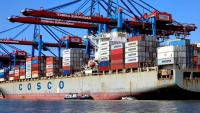You are here
Back to topGlobal Fruit Industry Facing Pressure From High Freight Rates

On Oct. 22, the United Nations Conference on Trade and Development published a report detailing how unprecedented disruptions along major shipping routes — including the Red Sea, Suez Canal and Panama Canal — combined with rising operational costs have resulted in increased shipping fees.
For the fresh fruit industry, the associated challenges go beyond mere cost pressures. Because fresh fruit products demand timely delivery, extended transportation times caused by route disruptions can adversely affect quality, delivery and sales. Delays due to vessel congestion often lead to market supply shortages, while the simultaneous arrival of multiple vessels can disrupt the balance of supply and demand, resulting in a sharp decline in market prices.
Amid the various impacts of shipping instability, rising costs remain a primary concern. In 2024, shipping fees have surged due to vessel rerouting, port congestion and increasing operational costs. By mid-2024, the Shanghai Containerized Freight Index had more than doubled compared with late 2023. As of Oct. 18, 2024, the SCFI had declined by 45% from its peak earlier in the year and was down 60% from the record levels observed during the COVID-19 pandemic. Nevertheless, it remained 115% higher than the pre-pandemic average and more than double the average value in 2023.
Alongside the key trans-Pacific and Europe-bound routes, spot freight rates have also seen significant increases. In the first seven months of 2024, the average rate on the SCFI Shanghai–South America route more than doubled to $9,026 per twenty-foot equivalent unit, representing its highest level since September 2022.
During the same period, the average rate on the SCFI Shanghai–South Africa route nearly tripled, climbing to $5,426 per TEU, the highest level since July 2022. Meanwhile, the average rate on the SCFI Shanghai–West Africa route surged by 137% to reach $5,563 per TEU, the highest level since August 2022.
Disruptions along key shipping routes, including the Red Sea, Suez Canal and Panama Canal, have markedly amplified the volatility of freight rates. Prolonged shipping distances, elevated fuel consumption and increasing insurance costs have all applied pressure on overall expenses.
Estimates from the United Nations Conference on Trade and Development indicate that climate change has resulted in declining water levels in the Panama Canal, contributing to a 45% overall increase in the Baltic Dry Index from October 2023 to January 2024.
The organization’s calculations also show that the Red Sea crisis and disruptions in the Suez Canal resulted in a 120% increase in the China Containerized Freight Index from October 2023 to June 2024.
According to data from London-based maritime research and consultancy firm Drewry, the Intra-Asia Container Index increased by 15% in the last two weeks of October, reaching $573 per 40-foot container. This marks the first rise after 12 consecutive weeks of decline since mid-July. Drewry anticipates that this upward trend will continue into November owing to the pre-Christmas cargo rush.
Image: Pixabay
This article was based on a Chinese article. Read the original article.














Add new comment